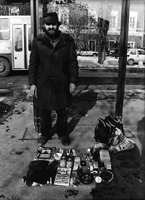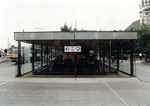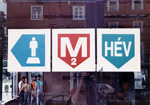A
plastic graphic symbol stuck onto glass next to existing graphics at
the Batthyany square metro station, indicating the new location of an
unofficial and forcibly relocated flea market.
Some
months after I installed the work, the market was cleared away from
its riverside location, only to re-emerge and become and established
feature at Hunyadi Square for a few years before being moved on again.
For some years now, a space for what is more or less the same market
has been made available by the local government for a low daily rent
within a walled yard between Nepstadion and Keleti train station - far
from the everyday passage of the public.
The
sign at Batthyany Square, which I hastily installed and quickly photographed
- thinking it would be taken down at any moment, lasted, much to my surprise,
until 2005, pointing at the parliament.
The
following text, which I wrote in 1996, gives some context to the work:
Market
Aesthetics
The
hidden problem of unemployment and homelessness, cushioned by Hungary's
former socialist system, materialised very suddenly after the economic
changes in 1989. Exposure to the laws and logic of market forces led
to the collapse and privatisation of many state-owned industries and
companies. The consequent downsizing and redundancy of the workforce
combined with rent inflation and the lack of any welfare system, to
produce a very new and visible homeless problem in Hungary. The government
presently funds a number of independent organizations who distribute
food and provide shelter for the homeless. However, an effective welfare
system is held back by local government bureaucracy and disputes between
districts over who is responsible for providing support to people who
are effectively urban nomads.
In
the spirit of enterprise which propels the system that forced them out
of employment and accommodation in the first place, many homeless people
have attempted to make small profits by recycling items selected from
the discarded waste of Budapest's citizens. These eclectic collections
of wares from super glue to broken alarm clocks are hawked in flea markets
such as the one that was established at Batthyany square until it was
moved last May. These markets, officially illegal in the inner city,
were for the most part popular among the people and tolerated as a temporary
solution by local government officials. In May, the Mayor of District
1 ordered the semi-permanent collection of homeless people to relocate
their market from Batthyany square to the nearby Bem rakpart, a cycle
track alongside the Danube directly opposite the parliament, to allow
for some renovation work. The suggested new location shifted the market
out of District 1 and onto land managed by the Budapest city government,
effectively passing the problem on.
Interested
in making interventions outside the gallery, I made some signs consisting
of generic symbols which, under the guise of objective information,
might encourage people to consider the everyday realities that surround
them. The sign on the glass metro wall mimics the official signs, conveying
official acknowledgement, and points ambiguously towards the parliament,
indicating both the shifting of location and responsibility.
Perhaps
the initial understanding and sympathy towards this problem is fading
and Hungary is beginning to experience an official attitude concurrent
with that in the West where homelessness is more established and where
park benches have been removed and laws introduced to legitimize the
clearing of 'vagrants' from public places. Freeing society from the
guilt of seeing the consequent and necessary bottom end of capitalism's
benefits imposes a split between our perception and reality and leaves
us in an unhealthy state of repression and denial.
Exhibitions:
Intermedia, Academy of Art, Budapest, May, 1996.




